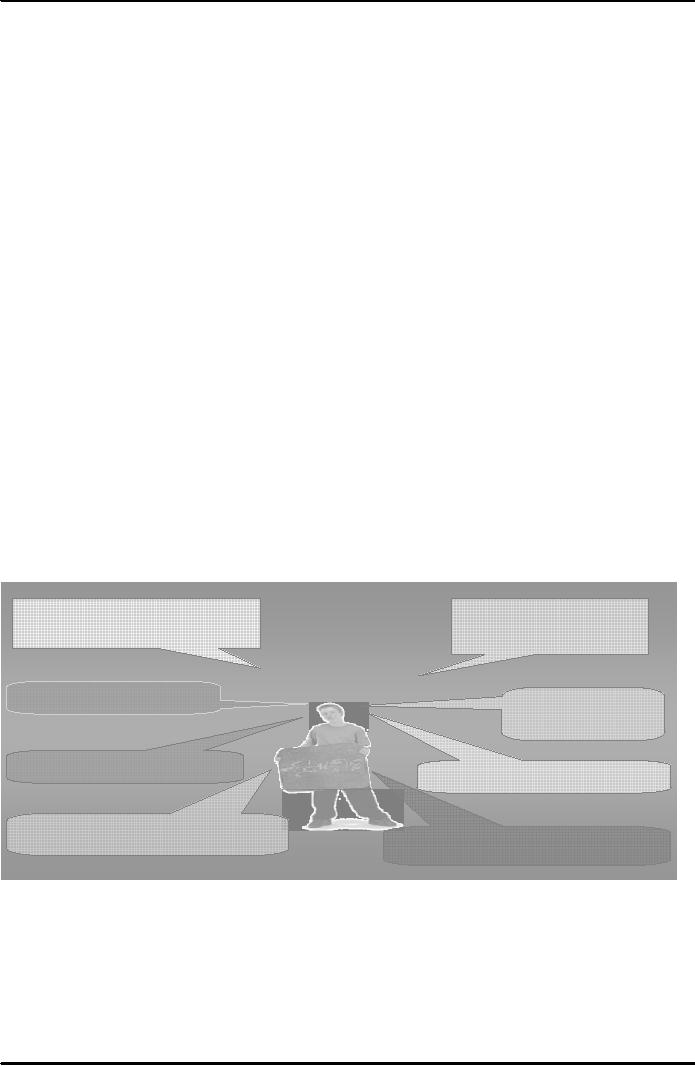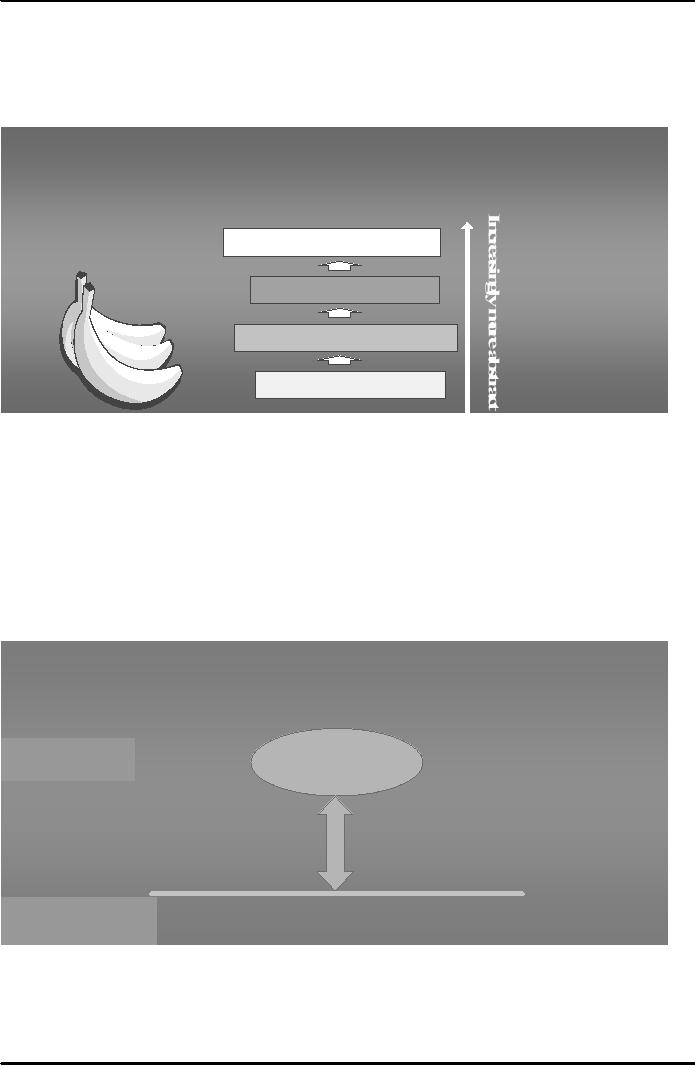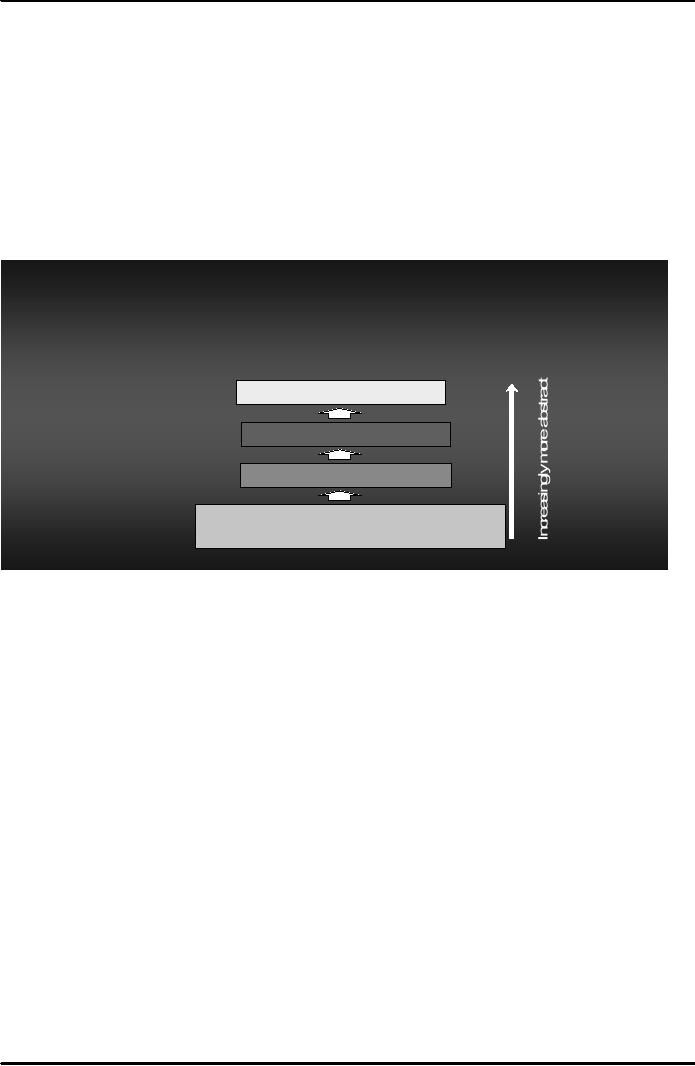 |
THEORY AND RESEARCH:Concepts, Propositions, Role of Theory |
| << CLASSIFICATION OF RESEARCH:Goals of Exploratory Research |
| CONCEPTS:Concepts are an Abstraction of Reality, Sources of Concepts >> |

Research
Methods STA630
VU
Lesson
4
THEORY
AND RESEARCH
The
purpose of science concerns the
expansion of knowledge, the discovery of
truth and to make
predictions.
Theory building is the means by
which the basic researchers hope to
achieve this purpose.
A
scientist poses questions like: What
produces inflation? Does student-teacher
interaction influence
students'
performance? In both these questions there is the
element of prediction i.e. that if we do
such
and
such, then so and so will
happen. In fact we are looking
for explanation for the
issue that has
been
raised
in these questions. Underlying the
explanation is the whole process
through which the
phenomenon
emerges, and we would like to understand
the process to reach
prediction.
Prediction
and understanding are the two
purposes of theory. Accomplishing the
first goal allows the
theorist
to predict the behavior or
characteristics of one phenomenon from the
knowledge of another
phenomenon's
characteristics. A business researcher
may theorize that older
investors tend to be more
interested
in investment income than
younger investors. This theory,
once verified, should
allow
researchers
to predict the importance of expected
dividend yield on the basis of
investors' age. The
researcher
would also like to understand the
process. In most of the situations
prediction and
understanding
the process go hand in hand i.e. to
predict the phenomenon, we must have an
explanation
of
why variables behave as they
do. Theories provide these
explanations.
Theory
As
such theory is a systematic
and general attempt to explain something
like: Why do people
commit
crimes?
How do the media affect us?
Why do some people believe
in God? Why do people
get
married?
Why do kids play truant
from school? How is our
identity shaped by culture?
Each of these
questions
contains a reference to some observed phenomenon. A
suggested explanation for the
observed
phenomenon
is theory. More formally, a
theory
is
a coherent set of general propositions,
used as
principles
of explanations of the apparent relationship of
certain observed phenomena. A key
element
in
this definition is the term
proposition.
A
systematic and
A
suggested
general
attempt to
explanation
for
explain
something...
something...
"Theory"
"Why
do people
"Why
do
commit
crimes?"
people
get
married?"
"How
does
the
"Why
do kids play truant
media
affect us?"
from
school?"
"Why
do some people
"How
is our identity
believe
in God?"
shaped
by culture?"
Concepts
Theory
development is essentially a process of
describing phenomena at increasingly
higher levels of
abstraction.
A concept
(or
construct) is a generalized idea about a
class of objects, attributes,
occurrences,
or processes that has been
given a name.
Such names are created or
developed or
constructed
for the identification of the phenomenon, be it
physical or non-physical. All these
may be
considered
as empirical realities e.g. leadership,
productivity, morale, motivation,
inflation, happiness,
banana.
11

Research
Methods STA630
VU
Concepts
are the building block of a
theory. Concepts abstract
reality. That is, concepts
are expressed in
words,
letters, signs, and symbols that refer to
various events or objects. For
example, the concept
"asset"
is an abstract term that may, in the
concrete world of reality,
refer to a specific punch
press
machine.
Concepts, however, may vary
in degree of abstraction and we can put
them in a ladder of
abstraction,
indicating different
levels.
A
Ladder Of Abstraction
For
Concepts
Vegetation
Fruit
Banana
Reality
Moving
up the ladder
of abstraction, the
basic concept becomes more
abstract, wider in scope,
and
less
amenable to measurement. The
scientific researcher operates at
two levels: on the abstract
level of
concepts
(and propositions) and on the empirical
level of variables (and hypotheses). At the
empirical
level
we "experience" reality that is we
observe the objects or events. In
this example the reality
has
been
given a name i.e. banana.
Moving up the ladder this
reality falls in wider
reality i.e. fruit, which
in
turn
becomes part of further
wider reality called as
vegetation.
Researchers
are concerned with the observable
world, or what we may call
as "reality." We try to
construct
names to such empirical
reality for its
identification, which may
referred to as concept at an
abstract
level.
Concepts
are
Abstractions
of Reality
Abstract
CONCEPTS
Level
Empirical
OBSERVATION OF OBJECTS
Level
AND
EVENTS (REALITY)
Theorists
translate their conceptualization of
reality into abstract ideas.
Thus theory deals
with
abstraction.
Things are not the essence
of theory; ideas are.
Concepts in isolation are
not theories.
Only
when we explain how concepts
relate to other concepts we
begin to construct theories.
12

Research
Methods STA630
VU
Propositions
Concepts
are the basic units of
theory development. However, theories
require an understanding of the
relationship
among concepts. Thus, once reality is
abstracted into concepts, the scientist
is interested in
the
relationship among various concepts.
Propositions
are
statements concerned with the
logical
relationships
among concepts. A proposition explains
the logical linkage among certain
concepts by
asserting
a universal connection between
concepts.
Theory
is an abstraction from observed reality.
Concepts are at one level of abstraction.
Investigating
propositions
requires that we increase our
level abstract thinking.
When we think about theories, we
are
at
the highest level of abstraction because
we are investigating the relationship
between propositions.
Theory
is a network of propositions.
Theory
Building Is A Process Of
Increasing
Abstraction
Theories
Propositions
Concepts
Observation
of objects
and
events (reality )
Theory
and Research
Basic
to modern science is an intricate
relation between theory and research.
The popular
understanding
of
this relationship obscures more
than it illuminates. Popular
opinion generally conceives of
these as
direct
opposites: theory is confused with
speculation, and thus theory
remains speculation until it
is
proved.
When this proof is made,
theory becomes fact. Facts
are thought to be definite,
certain, without
question,
and their meaning to be self
evident.
When
we look at what scientists
actually do when engaged in
research, it becomes clear (1)
that theory
and
fact are not diametrically
opposed, but inextricably
intertwined; (2) that theory
is not speculation;
and
(3) that scientists are
very much concerned with
both theory and fact
(research).
Hence
research produces facts and
from facts we can generate
theories. Theories are soft
mental images
whereas
research covers the
empirical world of hard, settled, and observable
things. In this way
theory
and
fact (research) contribute to
each other.
Role
of Theory
1.
Theory as orientation.
A
major function of a theoretical
system is that it narrows the range of
facts to be studied. Any
phenomenon
or object may be studied in
many different ways. A football,
for example, can be
investigated
within an economic framework, as we
ascertain the patterns of demand and
supply relating
to
this play object. It may
also be the object of chemical research,
for it is made of organic
chemicals.
It
has a mass and may be
studied as physical object
undergoing different stresses and
attaining certain
13

Research
Methods STA630
VU
velocities
under various conditions. It
may also be seen as the
center of many sociologically
interesting
activities
play, communication, group
organization, etc.
Each
science and each
specialization within a broader field
abstracts from reality,
keeping its attention
upon
a few aspects of given
phenomena rather than on all
aspects. The broad
orientation of each
field
then
focuses upon limited range of
things while ignoring or
making assumptions about
others.
2.
Theory as a conceptualization and
classification.
Every
science is organized by a structure of
concepts, which refer to
major processes and objects to be
studied.
It is the relationship between these
concepts which are stated in
"the facts of science."
Such
terms
make up the vocabulary that the scientist
uses. If knowledge is to be organized,
there must be
some
system imposed upon the facts
which are observable. As a consequence, a
major task in any
science
is the development of development of
classification, a structure of concepts, and an
increasingly
precise
set of definitions for these
terms.
3.
Theory in summarizing role.
A
further task which theory
performs is to summarize concisely what
is already known about the
object
of
study. These summaries may
be divided into two simple
categories: (1) empirical
generalizations,
and
(2) systems of relationships between
propositions.
Although
the scientist may think of his
field as a complex structure of
relationships, most of his
daily
work
is concerned with prior task: the
simple addition of data, expressed in
empirical generalizations.
The
demographer may tabulate births and
deaths during a given period
in order to ascertain the crude
rate
of reproduction. These facts
are useful and are
summarized in simple or complex
theoretical
relationships.
As body of summarizing statements
develops, it is possible to see relationships
between
thee
statements.
Theorizing
on a still larger scale,
some may attempt to integrate the
major empirical generalizations
of
an
era. From time to time in
any science, there will be
changes in this
It
is through systems of propositions
that many of our common
statements must be interpreted.
Facts
are
seen within a framework rather
than in an isolated
fashion.
4.
Theory predicts facts.
If
theory summarizes facts and
states a general uniformity beyond the
immediate observation, it
also
becomes
a prediction of facts. This
prediction has several facets.
The most obvious is the
extrapolation
from
the known to the unknown. For
example, we may observe that
in every known case
the
introduction
of Western technology has
led to a sharp drop in the death rate and
a relatively minor
drop
in
the birth rate of a given nation, at
least during the initial
stages. Thus we predict that if
Western
technology
is introduced into a native
culture, we shall find this
process again taking
place.
Correspondingly
we predict that in a region where
Western technology has
already been introduced,
we
shall
find that this process
has occurred.
5.
Theory points gaps in
knowledge.
Since
theory summarizes the known
facts and predicts facts
which have not been observed, it
must also
point
to areas which have not yet
been explored.
Theory
also points to gaps of a more
basic kind. While these
gaps are being filled,
changes in the
conceptual
scheme usually occur. An
example from criminology may
be taken. Although a substantial
body
of knowledge had been built
up concerning criminal behavior
and it causes. A body of
theory
dealing
with causation was oriented almost
exclusively to the crimes committed by
the lower classes.
Very
little attention has been
paid to the crimes committed by the
middle class or, more
specifically, to
the
crimes labeled as "white
collar" and which grow
out of the usual activities of
businessmen. Such a
gap
would not be visible if our
facts were not systematized
and organized. As a consequence, we
may
say
that theory does suggest
where our knowledge is
deficient.
Role
of Facts (Research)
Theory
and fact are in constant
interaction. Developments in one may
lead to developments in the
other.
Theory, implicit or explicit, is
basic to knowledge and even perception.
Theory is not merely
a
14

Research
Methods STA630
VU
passive
element. It plays an active role in the
uncovering of facts. We should expect
that "fact" has an
equally
significant part to play in the
development of theory. Science
actually depends upon
a
continuous
stimulation of fact by theory and of
theory by fact.
1.
Facts initiate theory.
Many
of the human interest stories in the history of
science describe how a
striking fact,
sometimes
stumbled
upon, led to important theories.
This is what the public
thinks of as a "discovery."
Examples
may
be taken from many sciences:
accidental finding that the penicillium
fungus inhibits
bacterial
growth;
many errors in reading, speaking, or
seeing are not accidental
but have deep and
systematic
causes.
Many of these stories take
an added drama in the retelling,
but they express a
fundamental fact
in
the growth of science, that an
apparently simple observation
may lead to significant
theory.
2.
Facts lead to the rejection
and reformulation of existing
theory.
Facts
do not completely determine
theory, since many possible theories
can be developed to
take
account
of a specific set of observation.
Nevertheless, facts are the more stubborn
of the two. Any
theory
must adjust to facts and is rejected or
reformulated if they cannot be fitted
into its structure.
Since
research is continuing activity,
rejection and reformulation are
likely to be going on
simultaneously.
Observations are gradually accumulated
which seem to cast doubt
upon existing
theory.
While new tests are
being planned, new
formulations of theory are
developed which might
fit
these
new facts.
3.
Facts redefine and clarify
theory.
Usually
thee scientist has investigated
his/her problem for a long
time prior to actual field or
laboratory
test
and is not surprised by his/her
results. It is rare that
he/she finds a fact that
simply does not fit
prior
theory.
New
facts that fit thee
theory will always redefine
the theory, for they state
in detail what the
theory
states
in very general terms. They
clarify that theory, for
they throw further light
upon its concepts.
Theory
and Research: the Dynamic
Duo
Theory
and research are
interrelated; the dichotomy between
theory and research is an
artificial. The
value
of theory and its necessity
for conducting good research
should be clear. Researchers
who
proceed
without theory rarely conduct
top-quality research and frequently
find themselves in
confusion.
Researchers
weave together knowledge from
different studies into more
abstract theory. Likewise,
who
proceed
without linking theory to
research or anchoring it to empirical
reality are in jeopardy of
floating
off
into incomprehensible speculation and
conjecture.
15
Table of Contents:
- INTRODUCTION, DEFINITION & VALUE OF RESEARCH
- SCIENTIFIC METHOD OF RESEARCH & ITS SPECIAL FEATURES
- CLASSIFICATION OF RESEARCH:Goals of Exploratory Research
- THEORY AND RESEARCH:Concepts, Propositions, Role of Theory
- CONCEPTS:Concepts are an Abstraction of Reality, Sources of Concepts
- VARIABLES AND TYPES OF VARIABLES:Moderating Variables
- HYPOTHESIS TESTING & CHARACTERISTICS:Correlational hypotheses
- REVIEW OF LITERATURE:Where to find the Research Literature
- CONDUCTING A SYSTEMATIC LITERATURE REVIEW:Write the Review
- THEORETICAL FRAMEWORK:Make an inventory of variables
- PROBLEM DEFINITION AND RESEARCH PROPOSAL:Problem Definition
- THE RESEARCH PROCESS:Broad Problem Area, Theoretical Framework
- ETHICAL ISSUES IN RESEARCH:Ethical Treatment of Participants
- ETHICAL ISSUES IN RESEARCH (Cont):Debriefing, Rights to Privacy
- MEASUREMENT OF CONCEPTS:Conceptualization
- MEASUREMENT OF CONCEPTS (CONTINUED):Operationalization
- MEASUREMENT OF CONCEPTS (CONTINUED):Scales and Indexes
- CRITERIA FOR GOOD MEASUREMENT:Convergent Validity
- RESEARCH DESIGN:Purpose of the Study, Steps in Conducting a Survey
- SURVEY RESEARCH:CHOOSING A COMMUNICATION MEDIA
- INTERCEPT INTERVIEWS IN MALLS AND OTHER HIGH-TRAFFIC AREAS
- SELF ADMINISTERED QUESTIONNAIRES (CONTINUED):Interesting Questions
- TOOLS FOR DATA COLLECTION:Guidelines for Questionnaire Design
- PILOT TESTING OF THE QUESTIONNAIRE:Discovering errors in the instrument
- INTERVIEWING:The Role of the Interviewer, Terminating the Interview
- SAMPLE AND SAMPLING TERMINOLOGY:Saves Cost, Labor, and Time
- PROBABILITY AND NON-PROBABILITY SAMPLING:Convenience Sampling
- TYPES OF PROBABILITY SAMPLING:Systematic Random Sample
- DATA ANALYSIS:Information, Editing, Editing for Consistency
- DATA TRANSFROMATION:Indexes and Scales, Scoring and Score Index
- DATA PRESENTATION:Bivariate Tables, Constructing Percentage Tables
- THE PARTS OF THE TABLE:Reading a percentage Table
- EXPERIMENTAL RESEARCH:The Language of Experiments
- EXPERIMENTAL RESEARCH (Cont.):True Experimental Designs
- EXPERIMENTAL RESEARCH (Cont.):Validity in Experiments
- NON-REACTIVE RESEARCH:Recording and Documentation
- USE OF SECONDARY DATA:Advantages, Disadvantages, Secondary Survey Data
- OBSERVATION STUDIES/FIELD RESEARCH:Logic of Field Research
- OBSERVATION STUDIES (Contd.):Ethical Dilemmas of Field research
- HISTORICAL COMPARATIVE RESEARCH:Similarities to Field Research
- HISTORICAL-COMPARATIVE RESEARCH (Contd.):Locating Evidence
- FOCUS GROUP DISCUSSION:The Purpose of FGD, Formal Focus Groups
- FOCUS GROUP DISCUSSION (Contd.):Uses of Focus Group Discussions
- REPORT WRITING:Conclusions and recommendations, Appended Parts
- REFERENCING:Book by a single author, Edited book, Doctoral Dissertation